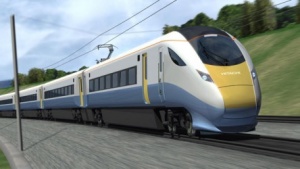HS2 benefits to extend across UK rail network

Over 100 towns and cities on Britain’s existing railway lines could benefit from quicker, more frequent journeys and better connections when HS2 phase two is complete, according to a new report published today by Network Rail.
The report on released capacity, ‘Better connections: options for the integration of High Speed 2’, sets out initial proposals for how HS2 could be integrated into the national rail network once the second phase connecting Birmingham with Leeds and Manchester is complete.
It considers three broad approaches to how the capacity released by HS2 could be used in advance of more detailed assessments of the benefits:
(i) ‘Do minimum’ approach – this would keep train services on existing lines broadly the same, offering reduced crowding and increased choice for passengers between high-speed and conventional long-distance services at certain locations;
(ii) ‘Incremental’ approach – this seeks to replace long distance services on the existing network which are replicated by those provided by HS2, allowing the capacity to be used for improved inter-urban connectivity and/or additional commuting capacity;
ADVERTISEMENT
iii) ‘Integrated connectivity’ approach – a more radical concept which would see all future rail services planned in a ‘hub and spoke’ model to complement and work in conjunction with HS2.
Paul Plummer, Network Rail group strategy director, said: “HS2 provides an opportunity to fundamentally reshape our railway in a way that incremental improvements simply cannot deliver. It is a chance to stop playing catch-up on capacity and instead look at how the rail network could deliver a step-change improvement towards key national goals – economic growth, reduced carbon emissions and an improved quality of life for communities and individual passengers.
“This study is part of a wider programme that looks at how the high speed and existing lines might work together as a single network. We will continue to work with local authorities and other stakeholders to understand how we can make best use of HS2 and welcome feedback on this initial study in advance of more detailed assessments of the benefits.”
Network Rail held a series of workshops with stakeholders to make sure that the report took into account local aspirations for connectivity and journey opportunities as well as plans for local and regional development. The workshops were attended by representatives of local authorities, passenger transport executives and chambers of commerce and were extremely valuable in determining priorities for future rail services.
The approach found to offer the greatest potential benefits was the integrated connectivity, or ‘hub and spoke’, option. This would see long distance services principally provided by HS2, with services on the existing network set up in a feeder pattern to provide frequent and reliable connectivity between surrounding areas and the ‘hub’ stations. It was felt by all stakeholders that this approach could create new opportunities to improve inter-regional, commuter and freight services and promote a shift in journeys from road to rail.
An incremental approach was also found to deliver significant improvements for passengers on the East Coast, Midland and West Coast main lines, with up to 100 stations on routes between London, the Midlands, the north west and the north east and Scotland potentially benefitting from faster and more frequent services offering new and better connections.
The ‘Better connections’ report complements an initial study published by Network Rail and Passenger Focus in January 2012 which looked at how capacity released from HS2 Phase One, between London and Birmingham, could be best used to meet passengers’ priorities.
This study found that one of the biggest groups to benefit would be commuters travelling between Northampton, Milton Keynes, Watford Junction and London Euston, where the worst overcrowding on the West Coast Main Line is forecast in the coming years as demand for rail continues to grow.

